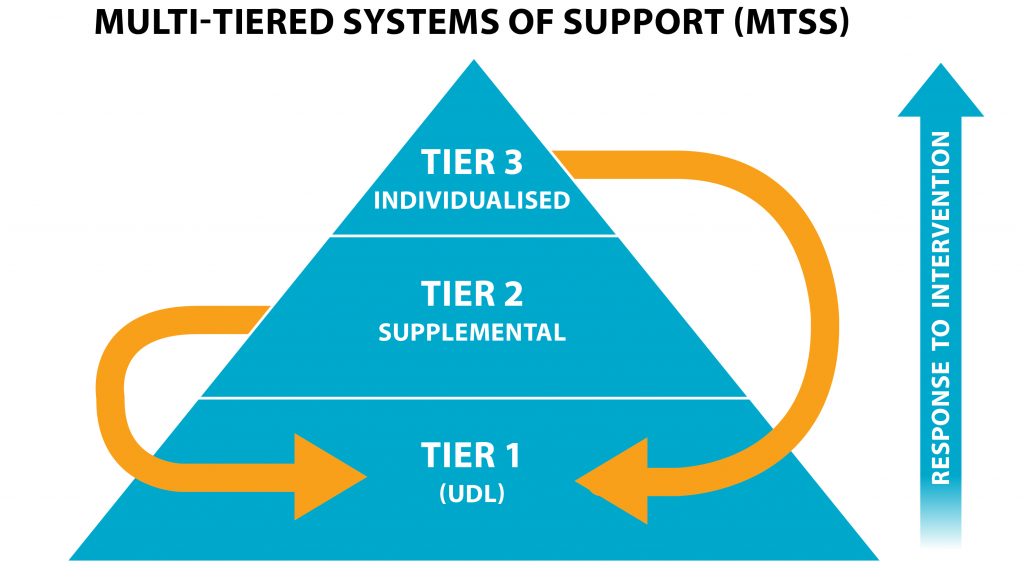REASONABLE ADJUSTMENTS
A reasonable adjustment refers to changes made in the classroom or school to enable a student with disability to participate in all activities on the same basis as other students.
This concept may be very familiar, especially if you have heard about or been involved in the Nationally Consistent Collection of Data (NCCD) on school students with disability.
To complete the NCCD, teachers must make judgements about whether students are receiving adjustments, and the level provided to each student.
Different levels of reasonable adjustments may reflect supports provided across levels, or tiers, as has been described as Multi-tiered Systems of Support.

Multi-tiered Systems of Support is a prevention model and is shown in this figure. Universal design principles are used in Tier 1 to meet different learning needs of students within a classroom. Assessment of need and of progress throughout the year provide teaching staff with information about how well students respond to instruction in Tier 1. Strategies in Tier 1 can include differentiated instruction or positive behaviour supports being used across the school.
Students move between tiers on the basis of their Response to Intervention: that is, if the student is not responding to Tier 1 level of support, a higher level of support is then provided.
Students who aren’t achieving class learning outcomes or behaviour expectations are given the next level of support intensity – Tier 2.
Here students may get more targeted instruction or behavioural intervention – this might be in small groups. If monitoring shows that students receiving Tier 2 interventions are not achieving grade level outcomes, they may move to Tier 3 support. This is given using individualised and targeted interventions, which could happen either within or outside the classroom, such as in a small room.
An important part of Multi-Tiered Systems of Support is shown by the arrows in this figure from Tiers 2 and 3 back to Tier 1 – the aim is to return students to Tier 1, to join the other students in their class, not to keep them separated from them.
Students may move back and forth between tiers according to individual need and what assessments show about their changing needs.
Universal Design for Learning principles are the basis for developing effective teaching interventions as outlined in an Australian school education text edited by Foreman and Arthur-Kelly (2017). In particular, the chapter by Arthur-Kelly and Nielands (2017) describes the following key considerations in effective teaching interventions:
- Beginning with strategic and pro-active planning to optimise learning for all students in the class
- Individual need and assessment data provide the basis for planning of supports (reflecting the
Response-to-Intervention principle) - Use of strategies that have research evidence
- There is a cyclic and dynamic processes of “assessing, planning, teaching and evaluating” (p. 210).
Identification of a student’s curriculum priorities comes from a teacher’s knowledge of the Australian Curriculum and judging whether the priorities for the class may result in difficulties for a student, which is then confirmed through assessment of the student.
For students with disabilities, Individual Education Plans, also known as Individual Learning Plans (in Victoria) are developed annually.
The Individual Learning Plan includes a series of statements that describe curriculum areas, learning goals and the supports the student will need to achieve each. Ideally, Individual Learning Plans are developed through involving the student, parent, teacher and special education teacher, and external consultants, such as allied health professionals.
Social or Medical Model?
The Multi-tiered Systems of Support model provides a way of considering how principles of the SMD can be applied within the school to create an inclusive learning experience for students with disabilities. Some students require more specialised supports, which may be provided at Tier 2 to some extent, but certainly at Tier 3.
The focus of this package is not on deciding the level of adjustments, but rather on designing
reasonable adjustments that could meet a student’s needs.
In this e-Learning package, we start with the SMD as the basis for developing reasonable adjustments, but draw on the MMD when it is appropriate to meet a student’s needs that may rely on more specialist skills. This approach uses aspects from both models and has been referred to as following a critical realist model.
In designing reasonable adjustments, the following criteria are considered to ensure both inclusion
and opportunity for real learning for a student with disability:
| Authenticity | The extent to which the adjustment results in a genuine learning activity, rather than simply occupying the student. |
| Real Learning | The extent to which the reasonable adjustment will address specific need so that the opportunity for the student to learn is enhanced. |
| Agency | The extent to which a student has choice or control in the activity. |
| Strengths-based | The extent to which the reasonable adjustment provides opportunities to incorporate a student’s skill strengths and interests to further build and extend their learning and development. |
| Inclusion | The extent to which the student is learning or engaged with peers in the same activities, even if additional supports are provided, or if the level or specific type of learning outcome differs. |
Next
In the next section, we address the importance of a team to develop the supports needed according to student need.

 Key concepts
Key concepts